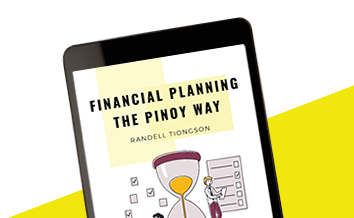Preparing for retirement, Pinoy style (Part 2)
By Randell Tiongson on October 25th, 2009
… con’t.
For the best investment for retirement, the top 3 answers were Real Estate, Time Deposits and Savings. There were very few respondents who made mention about more sophisticated instruments like life insurance, mutual funds, unit investment trust funds, stocks, bonds or structured notes. Ironically, quite a number of my respondents came from financial-related industries. If my respondents are an indication of the average middle class Filipino, you can surmise that we remain to be largely unsophisticated when it comes to investments. It is no wonder our capital markets are still highly undeveloped with most of the funds invested in short term savings and time deposits.
My 9th question actually reveals my theories on retirement planning in the country today. When asked why they think Filipinos do not take retirement planning seriously – my respondents talked about immediate gratification; ‘manana’ habit; lack of funds; poor income; increasing expenses; wrong priorities; short-term thinking; lack of knowledge; etc. Here’s an interesting reply from one of my respondents – “This is a big challenge for us in the financial industry. Filipinos are not too keen on preparing for their retirement maybe because of what we call the ‘extended’ family. Further, most parents are too busy preparing for their children’s future and they tend to forget to prepare for their old age. They will simple say, if I can provide a good future for my children they will look after me during my old age.” Obviously, this respondent belongs to the financial services industry and took the opportunity to express her disappointment. I remember hearing someone referring to it as the Filipino Financial Planning.
With regard to consulting with a professional, nearly all of my respondents thought it was a good idea. At least they acknowledge the fact that they will need help in this important area of their lives. Well, seeing a financial planner is really a good start; executing what the planner recommends is another story. The response to my final question should encourage the practitioners that there are people out there who would like to at least listen to what a planner has to say.
I must say that as I collate the responses, I was really concerned about the future of my fellow Filipinos. While most of our brothers and sisters agree that retirement is something that they should prepare for – actually doing it is easier said than done. Personally, my wife and I would really need to work on our retirement programs ourselves and writing this article was also a reminder for me.
The Bible actually talks about preparing for the future — many refer to it as the ‘Storehouse’ Principle. Come to think of it, retirement planning is just like filling our storehouses. Let us be consistent in filling up our storehouses so that when the time comes, we will have enough supply for our needs. Retirement planning is no different – we must be faithful in allocating for our retirement so the when we do retire, we will have more than enough. Just as God blesses the storehouses in the biblical times, God will bless our financial plans as well. Remember though, if one does not have a storehouse (or a retirement program in this case), what will God bless then?

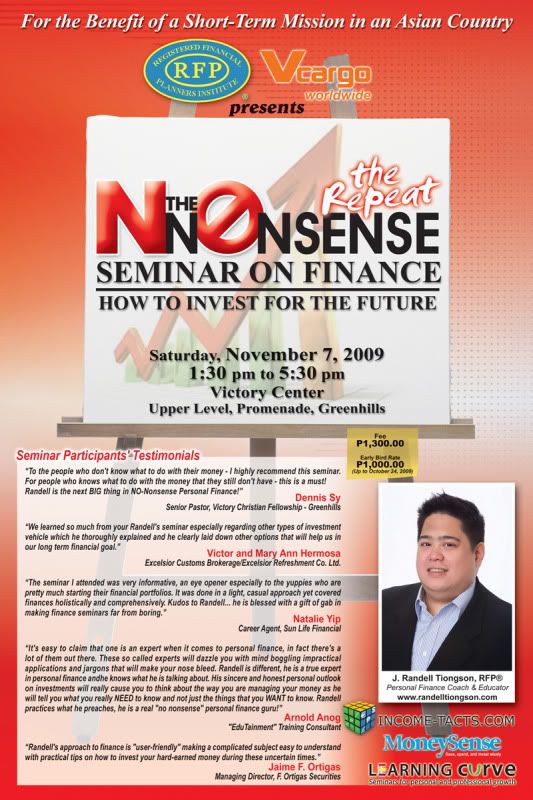
Preparing for retirement, Pinoy style (Part 1)
By Randell Tiongson on October 23rd, 2009
Ever wondered how Filipinos view retirement planning? After many years in the financial services industry, I have a pretty good idea how people view it. I’m sure Filipinos understand the importance of retirement planning but I was pretty sure that a lot of our brothers and sisters are not pro-active in this important area of their lives.
To validate my theories, I decided to run a short survey. There were about 100 respondents in my simple survey that I sent out via e-mail. The questions were:
1. Age, Sex
2. Profession
3. Annual Income
4. Desired Retirement Age
5. Do you have a structured retirement program in place? If so, what kind. If not, why not?
6. Do you think you will have enough money to live your retirement age comfortably?
7. In your opinion, when is the best time to start planning for retirement?
8. In your opinion, what is the best investment for Retirement?
9. In your opinion, why do you think Filipinos are not too interested in Retirement Planning?
10. Do you think it is a good idea to talk to a Professional to help you with Retirement Planning?
While I had some diverse answers to some of my questions, majority of the questions had similar answers and they were very close to what I expected. Let me tell you about the results.
For questions 1 to 3, I received dissimilar answers. The age of my respondents were quite broad, from 21 to about 50 but I would say the average respondents age would be somewhere between 30 to 35. Interestingly, there were more males who responded than females, as to why, I have no clue. Average income was also diverse, from minimum wage earners up to millionaires as I purposely wanted to get a broad range of respondents.
For the other questions, the answers were homogenous or very similar. Most of the respondents prefer to retire earlier that the usual 60 or 65 years old. Average target retirement age was about 50 years old. I guess my respondents do not see themselves working for very long and would like to get out of the rat race earlier than most. Here’s a disturbing revelation: while majority of my respondents wanted to retire early, majority of them do not have any retirement program in place. It makes you wonder how serious they are in wanting to retire early – it might just by wishful thinking for most of them, I suppose. For question # 6, most of my respondents agree that they may not have enough money to retire comfortably. Most of the respondents were unanimous in stating that with regard to retirement planning, ‘the earlier, the better’ principle applies – from the time one earns income or at least when one hits 30 years old. A good answer, in my opinion.
… to be continued
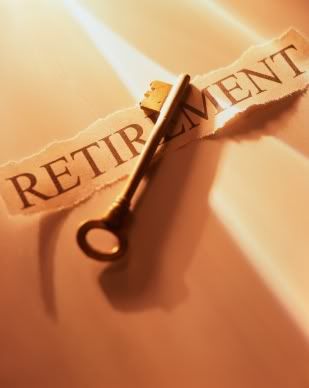
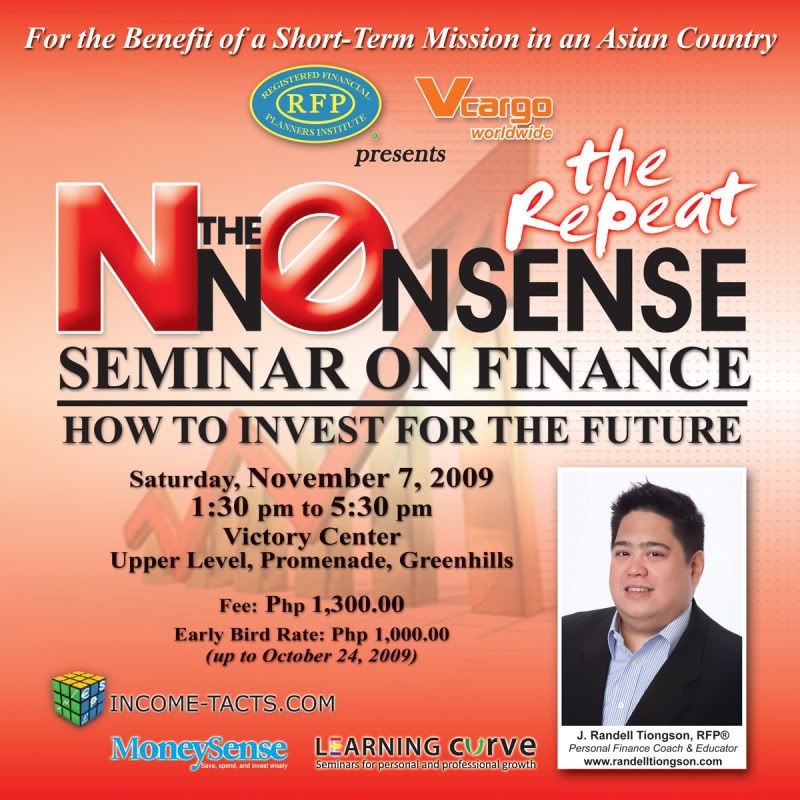
Building a strong foundation
By Randell Tiongson on October 20th, 2009
This appears in my column at the Business Mirror
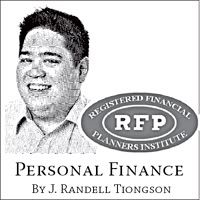 Not too long ago, people from everywhere would say that the Philippine peso was so weak and had so little value. I remember that many Pinoys would convert their money to US dollars because the peso loses values so fast, it seemed to be the prudent thing to do for them then.
Not too long ago, people from everywhere would say that the Philippine peso was so weak and had so little value. I remember that many Pinoys would convert their money to US dollars because the peso loses values so fast, it seemed to be the prudent thing to do for them then.
About five or so years ago, I met a person selling a financial product that would give you about 2-percent per-annum yield over 10-plus years. I challenged the person pushing the product because of the ridiculously low yield for an instrument that you needed to wait for at least a decade. The person selling the product told me the actual yield of the product was much higher if you factored the historical depreciation of the peso—he used 8 percent. He said that in reality, you actually got a product that gives you 10-percent annually. Duh! I remember politely telling him to change his sales pitch as he was treading on dangerously thin ice. I doubted that he followed my advice, though, as there were hordes of people selling horrible dollar-based financial products that capitalized on the weakening of the peso.
About the same time, I started telling people not to put too much of their money in US dollars because I felt that the appreciation of the US currency was too much, too fast and beyond logic. Even back then, studies showed that the US economy was not as strong as people thought it to be; in fact, it was a time bomb waiting to explode. No, I do not have a crystal ball. Nor am I a genius in forecasting. I merely urge people to diversify and exercise common sense.
When you put most your eggs in one basket, you are taking too much risk. Somehow, many people saw the American dollar as a risk-free endeavor…much like how some people see real estate or any other asset class of their liking. While it’s OK to have a “favorite” asset or asset class, we need to make sure that our bias for our preferences do not make us totally discard the value of diversification. Time often makes one realize there’s no such thing as “risk-free.”
Things change and times change. I remember my parents and grandparents telling us that the best investment we can make was land, land and land. I had a cousin who once told me that the best investments are those that are made in the stock market. My businessmen-friends would tell me that nothing beats having your own business. Well, they may be sensible and may be correct at some point. However, we can’t really make a judgment call on something that is relative…relative to our own perspectives. In the end, we always need to factor in the risks of our initiatives—is it OK to take the risk that is inherent to the endeavor we are undertaking? Is it consistent with the achievement of our financial objective? Did we consider the time frame for our undertaking? Too many questions, but they all deserve to be answered.
It is my belief that whatever undertaking we take in life, it must have good foundations—this is true with our investments as well. We need to develop our base on proper money management, appropriate savings and a lot of common sense—these are the foundations that would bring real prosperity.
“He is like a man building a house, who dug down deep and laid the foundation on rock. When a flood came, the torrent struck that house but could not shake it, because it was well-built” (Luke 6:48, NIV).
****************
Due to public demand, the “No-Nonsense Seminar on Finance: How to Invest for the Future” will be having a repeat on November 7, 2009, from 1:30 to 5:30 p.m. at the Victory Center, Upper Level, Promenade, Greenhills. To learn more about the event, visit https://randelltiongson.com. Catch the early- bird rate if you register and pay before October 24, 2009.






 Not too long ago, people from everywhere would say that the Philippine peso was so weak and had so little value. I remember that many Pinoys would convert their money to US dollars because the peso loses values so fast, it seemed to be the prudent thing to do for them then.
Not too long ago, people from everywhere would say that the Philippine peso was so weak and had so little value. I remember that many Pinoys would convert their money to US dollars because the peso loses values so fast, it seemed to be the prudent thing to do for them then.